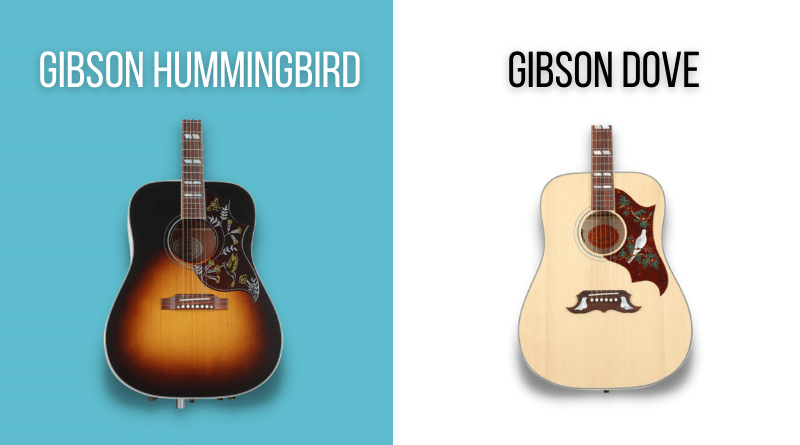The Dove and Hummingbird are two of Gibson’s most iconic models, and yet, people are often very quick to confuse the two with one another. When making a comparison of the Gibson Dove vs Hummingbird, the majority tend to focus on the superficial aesthetics, which is where the majority of the similarities between these guitars lie.
What most don’t realize is that there are some significant differences beyond the species of bird featured on the pickguards! In this KillerGuitarRigs Guide, we’ve taken a deep dive into both of these amazing guitars to find out what the differences are, and to help you deduce which one would be better for you.
If you’re in the market for a high end acoustic, or you’re just keen to learn more, you’ll definitely want to keep on reading.
Read more about our review process.
Contents
Main Differences Between the Dove and the Hummingbird
While the Gibson Dove and Hummingbird are visually very similar, there are some major differences across a number of areas of the two.
Body Material
One of the most prominent differences between the two guitars is the choice of woods. The Hummingbird is made with a much more traditional wood selection, namely Sitka spruce on the top and mahogany (or in some cases rosewood) on the back and sides.
The Dove, on the other hand, is made with a Sitka spruce top and maple on the back and sides. This is quite a unique combo of woods and it really sets the Dove apart.
Not only are there material differences on the bodies, but also on the necks. The Dove is fitted with a beautiful flamed maple 3 piece neck, while the hummingbird has a lovely mahogany neck.
Scale Length
Another significant difference between the Dove and the Hummingbird comes with their scale length. The Hummingbird has a much more familiar (to Gibson player) 24.75” scale, whereas the Dove sports a much longer 25.5” scale.
When trying to remember which is which, simply think of the birds the guitar is named after. Hummingbirds are smaller than Doves
Hardware
When it comes to hardware, there are a few more differences between these guitars. The Dove, for example, is fitted with chromed Grover tuners with keystone pegs. The Hummingbird, on the other hand, has gold plated Kluson tuning machines with plastic pegs. Both provide great tuning performance, but radically different looks.
While both models have large, ornate pickguards, the two also differ in their bridge design. The Dove has a mustache style bridge, with inlaid birds either side of the saddle. The hummingbird has a much more plain bridge with no inlay.
Gibson Hummingbird
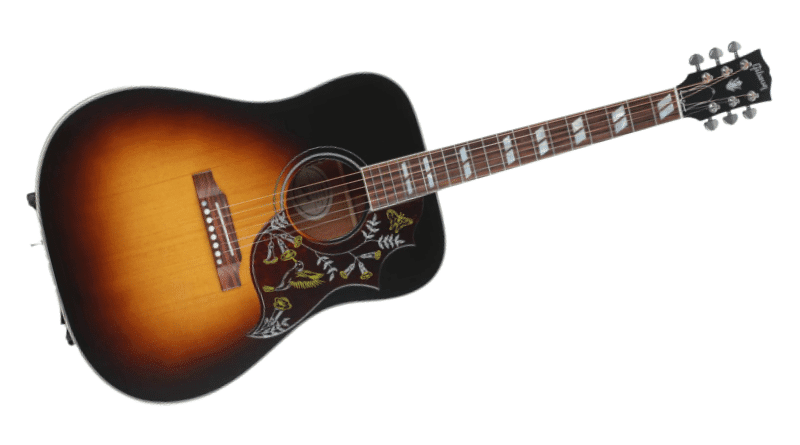
The Gibson Hummingbird was introduced in 1960 as Gibson’s very first square shoulder dreadnought acoustic. It’s known for its distinct look and sound, and it has been used by some of the most famous musicians in the world. The Hummingbird has always been a high end model, and on its debut, it was the company’s second most expensive model, just behind the flagship J-200.
When the Hummingbird was first introduced, it was specifically designed to compete with Martin guitars – one of the most renowned guitar manufacturers in the world. This model took its name directly from its hand etched pickguard, originally designed by Gibson Custom Shop employee, Hartford Snider. Snider was a renowned nature artist, and was given the freedom to design the now iconic pickguard motif that came to be known as, “Hummingbirds In Flight”.
Over the years, the Gibson Hummingbird has been used by many famous musicians including Keith Richards, Bob Dylan, and Sheryl Crow to name but a few – These artists have all helped to make the Hummingbird one of the most iconic acoustic guitars in history.
Construction
The Gibson Hummingbird relies on the classic acoustic formula of spruce and mahogany, although some variants are made with rosewood in place of the mahogany. These combinations of woods provide well balanced tones that work perfectly with the dreadnought shape and are well suited to practically every genre.
All Hummingbirds are manufactured in the USA at Gibson’s Bozeman, MT, and as a result are built to an extremely high standard. One such indicator of quality is that these guitars are coated with a genuine nitrocellulose lacquer that allows the wood to breathe better than any polyurethane alternative. This is a more labor intensive process, but the results speak for themselves.
As mentioned, the Hummingbird has a large, square shoulder dreadnought body shape, which was something of a departure from the slope shouldered dreadnoughts and curvy jumbos Gibson had made up until that point.
Tones
There are few acoustic tone wood pairings that can quite capture the sonic magic of mahogany and Sitka spruce. The mahogany provides warmth, and excellent sustain, while adding midrange focus. The Sitka spruce adds lashings of top end sparkle, as well as strong volume and projection.
Its balance combined with its excellent projection makes it equally at home strumming cowboy chords as it is on single note runs and solos, which explains a lot about why it’s so popular with so many world class guitarists.
Playability
There are a number of factors contributing to its incredible playability. First of all, it has a short scale at 24.75”, making it feel more like one of Gibson’s electric guitars. Not only does this improve playing speed, it also reduces the string tension, making it much more comfortable than similar guitars with 25.5”+ scales.
The lower string tension is a big part of the reason that lead players love the hummingbird so much. It allows for easy bends, making solos a much more manageable affair than on most dreadnoughts.
Its round profile neck has a smooth, satin finish, which once again increases comfort and speed while playing, and promotes proper form when fingering notes and chords.
Favorite Models
Gibson Hummingbird Standard
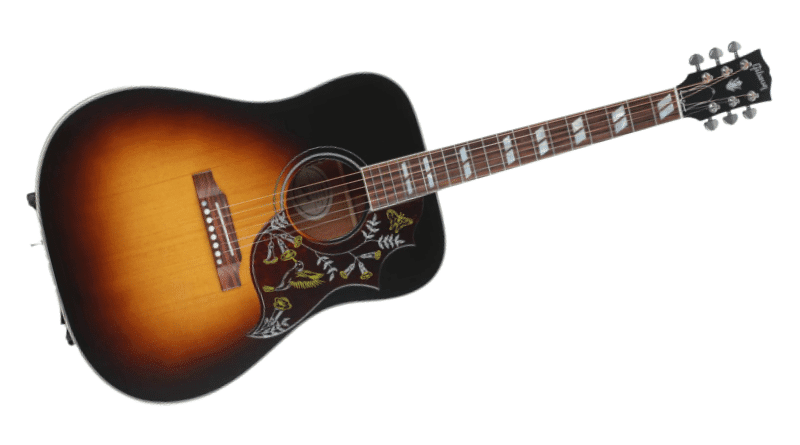
Being a Standard series model, the Gibson Hummingbird Standard is a full featured model, from the all solid wood construction through to the Kluson tuners and gold plated hardware. It’s brilliantly playable, with its comfortable short scale, and works for both rhythm and lead players alike. It strikes a great tonal balance, and is an excellent choice if the idea of a reduced scale dreadnought appeals to you.
Gibson 1960 Hummingbird
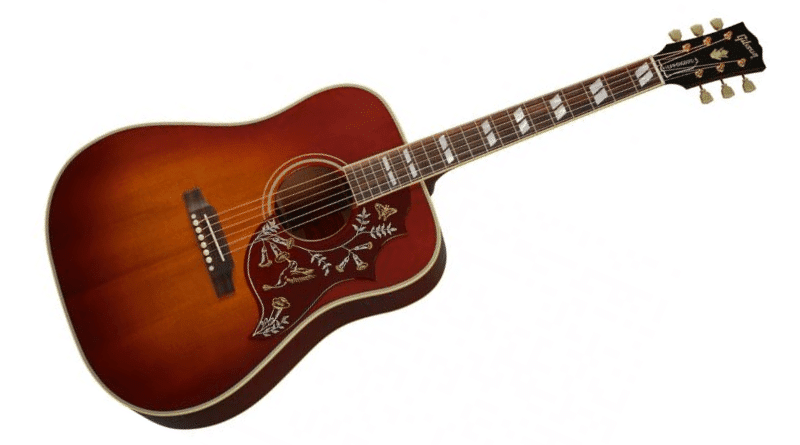
The Gibson 1960 Hummingbird makes use of specially selected thermally aged Sitka spruce for the top, giving it the tone and feel of a genuine 1960s antique model. It offers wonderfully nuanced tones that are palpably different from those of Hummingbirds with standard spruce tops. Its nitro finish is ultra thin, allowing the guitar to vibrate more easily, and for the wood to breathe, contributing significantly to its almost endless sustain and gorgeous organic tones.
Gibson Hummingbird Studio
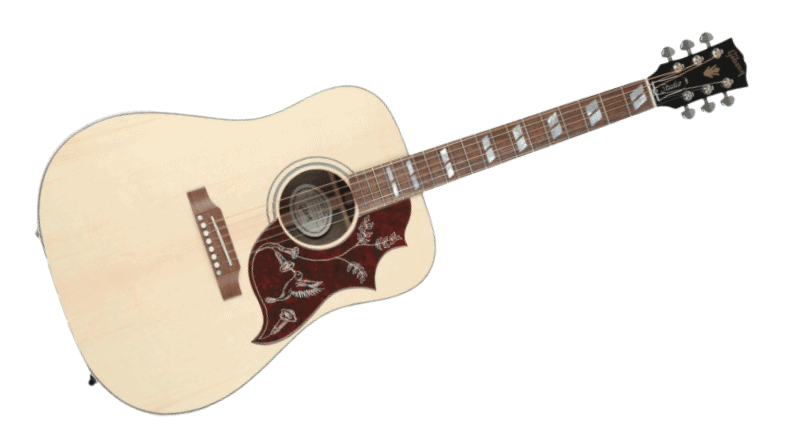
The Gibson Hummingbird Studio is a new entry level model in the Gibson Hummingbird family. It offers the same dimensions as the standard, but with simpler aesthetics, especially on the pickguard. It has the same solid spruce on top, but walnut on the back and sides, giving it a slightly brighter tone, and a lighter color. Besides that, you still get Grover Rotomatic tuners, and proper parallelogram inlay, so it very much looks the part. The best part? It’s well over $1000 less than the Standard.
Epiphone Hummingbird
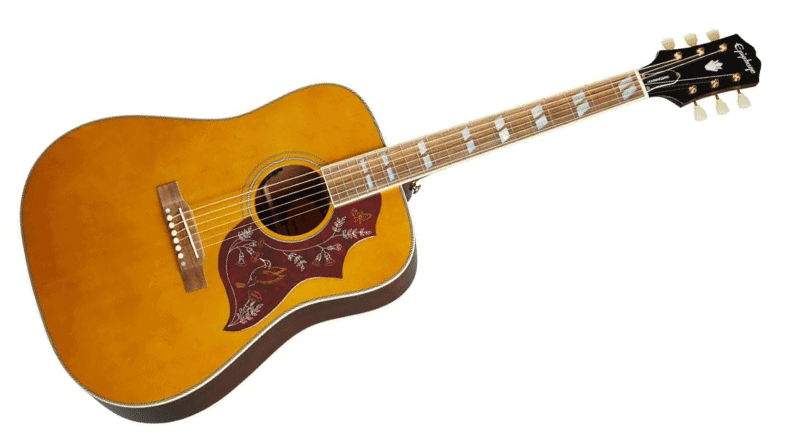
Once again, Epiphone has come in clutch with a phenomenal cut price version of a Gibson classic. The Epiphone Hummingbird is from their “Inspired By” series, which are about as close to Gibson models as you’ll get without actually buying one. It looks and feels very much like a Hummingbird Standard, right down to the hardware. Where it differs is the use of Fishman electronics over the LR Baggs on the Gibson, and it uses a polyurethane finish instead of nitro. At less than ¼ the price of a Gibson Hummingbird Standard, it definitely gives you pause to stop and think.
Gibson Dove
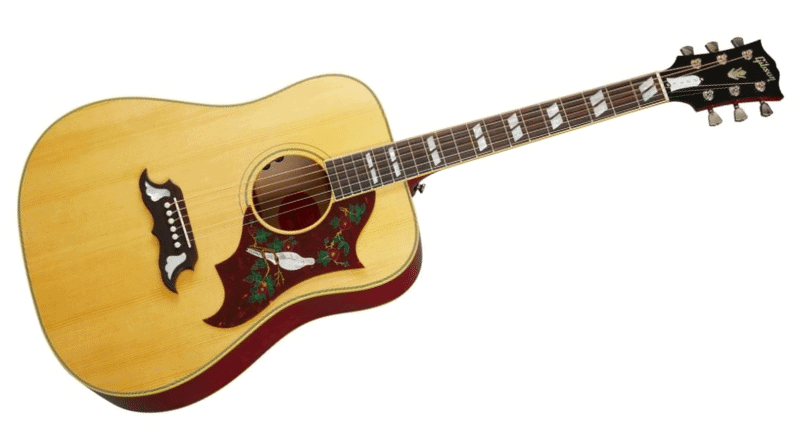
The Gibson Dove was a follow up to the incredibly popular Hummingbird, and was introduced two years later in 1962. Like the Hummingbird, it featured a square shoulder design, and was originally built in Kalamazoo, MI.
Like the Hummingbird, it was designed with a beautifully ornate pickguard, once again designed by Hartford Snider. The Dove took things up a notch in respect of embellishments, and employed a radical change in terms of the tone woods in use. The Dove was, and remains the more expensive of the two models, and is generally seen as the more premium choice.
The result was yet another unique sounding guitar that once again, attracted the attention of music royalty, with the likes of John Cougar Mellencamp, Tom Petty, and even the King himself, Elvis Presley, favoring this particular model.
Construction
The Gibson Dove, like many Gibson acoustics (including the hummingbird), is made with a solid Sitka spruce top, but where it differs is with the tone woods used for the back and sides. Quite uniquely, the Dove uses solid maple in the construction of its back and sides, which delivers a totally different tonal palate to that of mahogany or rosewood.
It has the same full size, square shoulder dreadnought body as the Hummingbird, but it features a noticeably larger 25.5” scale length.
Interestingly, early models were prized for their projection and volume, but unfortunately faced many structural issues. Because of the amount of warranty work Gibson found themselves performing, in 1968 they modified the bracing, making it heavier, but consequently the volume and tone suffered as a result. By time production shifted from Kalamazoo to Bozeman, Montana in 1992, many of the quality related issues had been addressed, and the original performance of the Dove was restored.
Tones
Tonally, the Gibson Dove is a much brighter sounding guitar than the Hummingbird. The longer scale length and associated string tension also helps with clarity and volume. It offers incredible note separation while still producing plenty of overtones, which really helps the sound come together in a fantastically harmonic way.
Assisting with the overall clarity of the guitar is the use of maple in the back and sides. Maple is used on many of Gibson’s electric guitars to add bite and snap to the tone, and it performs in much the same way with the dove. It has a beautifully defined top end, and because of the square shoulder dreadnought design, it has huge punch and projection.
Playability
The Dove plays very much like a vintage guitar. It has a thick, rounded neck, which when paired together with the long scale length and beefy dreadnought body, it might not feel like the world’s most ergonomic guitar, especially for younger, smaller, or less experienced players.
It’s a guitar that very much lends itself more to rhythm style playing than anything else. Beside its ability to literally slice through a mix, physically speaking, it’s quite a limiting model when it comes to solos and lead work.
The longer scale length makes bending notes more difficult, which over a prolonged period can be quite uncomfortable and even fatiguing. However, when strumming, there’s a lot of body to support the strumming arm, and the additional string length allows for some great variation in playing dynamics.
Favorite Models
Gibson Dove Original

The Gibson Dove Original delivers the robust projection and crystal clear tones that the model is so famous for. It’s well equipped with Grover tuners, a bone nut, and of course, genuine mother of pearl inlay on the fretboard, pickguard, and even on the bridge. Live performers will appreciate the LR Baggs VTC acoustic pickups, and anybody who picks it up will appreciate the craftsmanship and attention to detail.
Gibson Doves in Flight
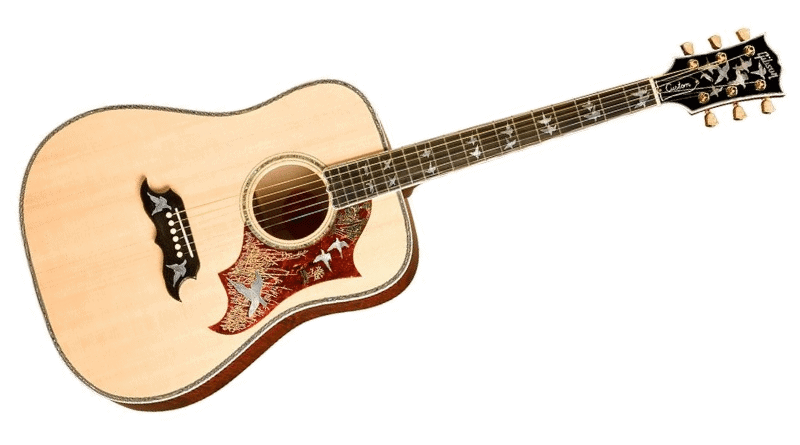
This Doves in Flight edition of the Gibson Dove is without a doubt one of the best looking guitars ever to come from a Gibson factory. It’s beautifully embellished without being garish – a fine line to tread, and a difficult thing to get right. From the abalone binding to the stunning imagery depicted on the pickguard and fretboard, it’s a real head turner, and of course, it has the performance to back it all up.
Its tones are absolutely breathtaking, with just the right blend of everything, from a booming bottom end, to mid range punch and sparkling top end.
Gibson Elvis Dove
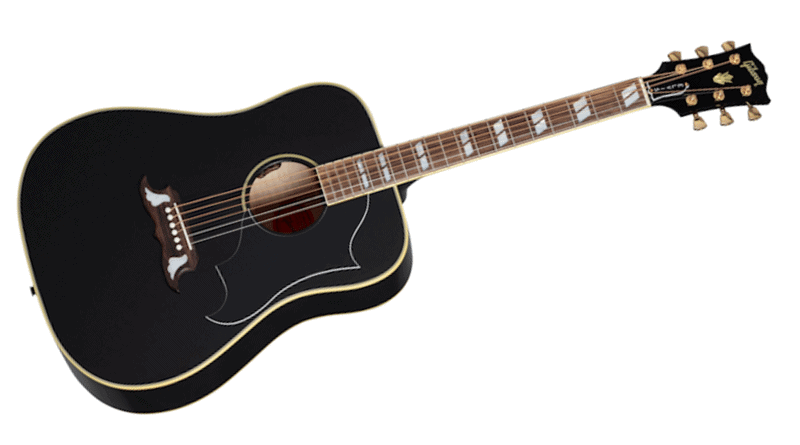
While technically speaking it’s not a signature model, the Gibson Elvis Dove is modeled after an all black Dove given to Presley by his dad in 1969. The dove tones became closely associated with his sound, and it perfectly suited his aggressive strumming style. Like other versions, it comes with an LR Baggs VTC pickup system, a solid Sitka spuce top, and solid mahogany on the back and sides. This is a great option for those who like a more subtle guitar, as the pickguard (which retains the dove shape), is plain black with no engraving.
Epiphone Dove Studio
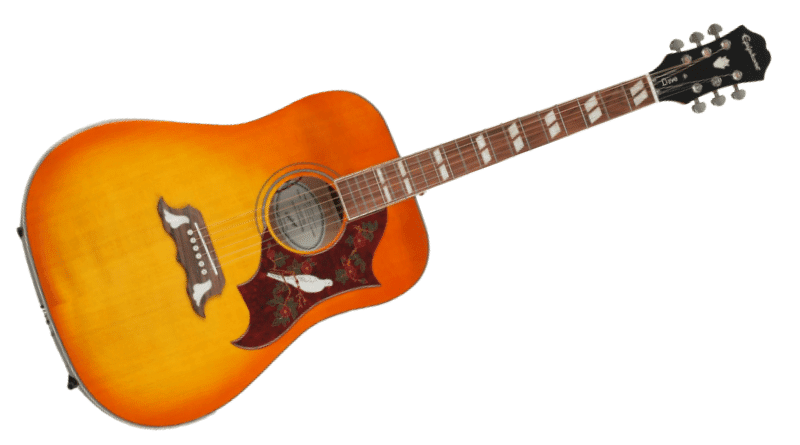
If you’re looking for a great Dove, but you’re trying to keep costs down, the Epiphone Dove Studio is the way to go. As is correct for the model, it’s made with a solid spruce top and maple back and sides, and of course, it comes with the iconic pickguard and inlaid mustache bridge. It even has the parallelogram inlay on the fretboard. The finish is a gorgeous violin burst, and for those looking to plug in and play to an audience, it’s pre loaded with Fishman electronics. At around a tenth of the price of a Gibson, it’s an excellent value proposition.
Final Thoughts on the Gibson Dove vs. Hummingbird
We’ve always been big fans of both of these guitars at KGR, and we hope we’ve been able to clear up some of the confusion that often surrounds them. No matter whether you go for a Gibson Hummingbird or a Gibson Dove, you’re going to be getting an incredible instrument. Even if you opt for a more affordable Epiphone model, you’ll be buying a workhorse that delivers most of what you’re looking for.
To recap, the Dove (just like the bird) is slightly larger than the Hummingbird, with its 25.5” scale vs a 24.75” scale. The Dove is a louder, punchier guitar, while the Hummingbird is more mellow, and arguably far better for lead guitar work.

